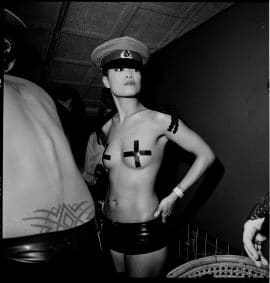Artist: Gerard Wessel
The Barbarians entertain the female audience, Amsterdam, 1994
Hahnemühle Baryta print, 38x38cm
Literature: Circus Amsterdam; Photography Gerard Wessel, publ. Lecturis, 2016.
“Noem mij geen nieuwsfotograaf”, zegt Gerard Wessel “want eigenlijk ben ik een traditionele straatfotograaf. Zwervend door de stad met een kleinbeeldcamera en zonder afspraken, voel ik mij het gelukkigst”. Het is de bekentenis van iemand die grote bewondering heeft voor de New Yorkse nieuwtjesjager Weegee, de Amerikaanse fotografe Diane Arbus. maar ook de poëtische benadering van modefotograaf Paolo Roversi.
Meteen na zijn studie aan de Haagse School voor Fotografie en Fotonica, werd Wessel in 1985 staffotograaf van Nieuwe Revu en is hij mede door dit weekblad bekend geworden als chroniqueur van de Nederlandse jeugdcultuur en als ‘hoffotograaf’ van popster Herman Brood. Van het uitgaansleven in Nederland heeft hij inmiddels een aanzienlijk fotoarchief, dat – zeker op termijn – van onschatbare waarde is voor de geschiedschrijving van de jongerenvrijetijdsbesteding vanaf het midden van de jaren 80. Net als de eveneens door hem bewonderde fotograaf Cas Oorthuys, steekt Wessel evenveel tijd in het archiveren en categoriseren van zijn fotografische productie als in het fotograferen zelf. Hij is zich ervan bewust dat hij doorlopend wisselende tijdsbeelden belicht, waarin aspecten van politiek, muziek, mode en beeldende kunst samenkomen, en dat deze niet alleen voor het moment nieuwswaardig zijn maar ook een belang voor de toekomst hebben. Hoewel Wessel zichzelf het liefst als straatfotograaf ziet, getuig zijn werk – veel meer dan dat van zijn illustere voorgangers – van een ‘cleane’ esthetiek, die een hang naar afstand en systematiek verraad. Hij maakt van zijn onderwerpen geen tientallen snapshots, maar weloverwogen composities met een 6 x 6 Rolleiflex-camera. Hierdoor krijgen zijn foto’s een serene, uitgebalanceerde studiokwaliteit, terwijl ze toch dikwijls onder de moeilijkste omstandigheden en op de meest lastige locaties tot stand zijn gekomen, zoals in clubs, op straat en tijdens popfestivals.
De laatste jaren richt Wessel zich meer op de portretfotografie en werkt hij samen met historicus Bram de Graaf regelmatig voor Volkskrant Magazine.
In 2015 is een collectie foto’s van Gerard Wessel aangekocht door het Rijksmuseum.
“Don’t call me a news photographer,” says Gerard Wessel, “because I’m actually a traditional street photographer. I feel happiest wandering through the city with a 35mm camera and without appointments”. It is the confession of someone who has great admiration for the New York news hunter Weegee, the American photographer Diane Arbus, but also the poetic approach of fashion photographer Paolo Roversi.Immediately after his studies at the Hague School for Photography and Photonics, Wessel became a staff photographer for Nieuwe Revu (the biggest illustrated weekly) in 1985 and, partly because of this weekly, he became known as a chronicler of Dutch youth culture and as the “court photographer” of pop star Herman Brood. He now has a considerable photo archive of nightlife in the Netherlands, which – certainly in the long term – is of inestimable value for the historiography of youth leisure activities from the mid-1980s. He is aware that he highlights continuously changing time images, in which aspects of politics, music, fashion and visual art come together, and that these are not only newsworthy for the moment, but also have an importance for the future. Although Wessel prefers to see himself as a street photographer, his work – much more than that of his illustrious predecessors – testifies to a “clean” aesthetic, which betrays a penchant for distance and systematics. He does not make dozens of snapshots of his subjects, but carefully considered compositions with a 6 x 6 Rolleiflex camera. This gives his photos a serene, well-balanced studio quality, while often being created under the most difficult conditions and in the most difficult locations, such as in clubs, on the street and at pop festivals.In recent years, Wessel has focused more on portrait photography and has regularly collaborated with historian Bram de Graaf for Volkskrant Magazine.
In 2015, a collection of photos by Gerard Wessel was purchased by the Rijksmuseum Amsterdam.










There are no reviews yet.